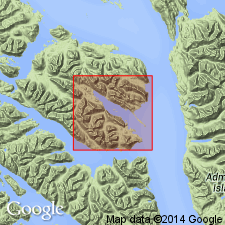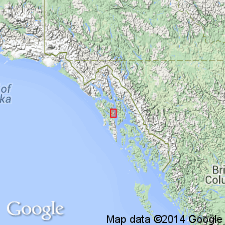
- Usage in publication:
-
- Gypsum Creek quartz monzonite*
- Modifications:
-
- Named
- Dominant lithology:
-
- Quartz monzonite
- AAPG geologic province:
-
- Alaska Southeastern region
Summary:
Named applied to quartz monzonite in pluton at head of Gypsum Creek, Freshwater Bay area, Chichagof Island, southeastern AK. Forms elongate west-northwest-trending outcrop 5.5 mi long and that averages 0.75 mi wide. Occupies central part of Freshwater Bay syncline and is almost entirely surrounded at surface by limestone of upper part of Iyoukeen formation (new). Age can be determined no closer than post-Late Mississippian and pre-Quaternary.
Source: GNU records (USGS DDS-6; Menlo GNULEX).

- Usage in publication:
-
- Gypsum Creek Quartz Monzonite*
- Modifications:
-
- Age modified
- Geochronologic dating
- AAPG geologic province:
-
- Alaska Southeastern region
Summary:
K-Ar age of 103+/-5 Ma on biotite (R.F. Marvin, written commun, 1964) and lead-alpha age of 150 +/-20 Ma for coexisting zircon (T.W. Stern, written commun., 1963) differ by more than analytic uncertainty, but these ages indicate probable Cretaceous(?) age for Gypsum Creek Quartz Monzonite.
Source: GNU records (USGS DDS-6; Menlo GNULEX).
For more information, please contact Nancy Stamm, Geologic Names Committee Secretary.
Asterisk (*) indicates published by U.S. Geological Survey authors.
"No current usage" (†) implies that a name has been abandoned or has fallen into disuse. Former usage and, if known, replacement name given in parentheses ( ).
Slash (/) indicates name conflicts with nomenclatural guidelines (CSN, 1933; ACSN, 1961, 1970; NACSN, 1983, 2005, 2021). May be explained within brackets ([ ]).

